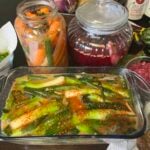Today I have a new kimchi for you, made with green onions! It’s called Pa-kimchi (파김치) in Korean or you can call it green onion kimchi! Pa-kimchi is very aromatic, strong, spicy, crispy and much easier to make than traditional Korean baechu kimchi (napa cabbage kimchi). You make it with the whole green onion, both the white and green parts. Compared to napa cabbage kimchi, making pa-kimchi is so easy because you don’t need many ingredients. You won’t need the garlic, ginger, radish, and chives essential for making cabbage kimchi.
The green onions used for pa-kimchi in Korea are thin and long and usually sold in huge bunches. After mixing with kimchi paste, I sometimes made a bundle with a few green onions and stacked them up in my kimchi container. So when I served them, I just took out one bundle and put it on a plate or bowl. But when I was busy, I used to store all the tangled green onion kimchi together in an airtight container. Pa-kimchi is a big deal in Korea and we eat it all the time. South Jeolla province, where I am from, is well known for its spicy and pungent green onion kimchi.
Here in America the onions are thicker and usually trimmed, and sold in smaller bunches, so I needed to adapt my way of making pa-kimchi.
Are you ready to make pa-kimchi now? If so, these are some tips for you.
- The green onion roots you chop off are good for making stock. You can add them to your anchovy kelp stock or vegetable stock.
- When you finish eating, you may have some leftover kimchi paste. You can add it to your kimchi bokkeumbap, kimchi stew, kimchi soup, or kimchi pancake to enhance the flavor.
- If you are vegetarian, substitute soup soy sauce for fish sauce.
Ingredients
- 3 pounds green onions, roots trimmed
- 1 cup fish sauce
- ¼ cup glutinous rice flour (aka “sweet rice flour”)
- 2 tablespoons white or brown sugar
- 1½ cup gochugaru (Korean hot pepper flakes)


Directions
Prepare onions
- Cut off the roots of green onions. Remove any tough outer layers of green onions and discard. Cut them into halves crosswise. Wash the green onions in a couple changes of cold water. Drain and put them in a large bowl.

- Mix with the fish sauce with both hands.

- Let stand for 1 hour, turning over every 20 minutes to salt evenly.

Prepare paste
- Meanwhile, combine the glutinous rice flour and 3 cups water in a saucepan. Mix it well. Place over medium high heat and stir until the mixture begins to bubble, 4 to 5 minutes.
- Add the sugar and stir for another minute, until the paste looks slightly translucent.

- Remove from the heat and let cool thoroughly.
Make kimchi
- Transfer the salted green onions to a large bowl by hand and reserve the mixture of fish sauce.
- Scrape the cooled porridge into the bowl with the fish sauce mixture. Add the hot pepper flakes and mix well with a wooden spoon. Let it sit for 30 minutes until the hot pepper flakes are soaked in the mixture and the paste thickens a little.

- Add the green onions and gently toss and mix together by hand (wear disposable gloves if you like).


- Transfer to an airtight container or a glass jar. Press down on the kimchi so it’s well packed and no air can get inside, then put the lid on the container.

Serve and ferment
- You can serve the kimchi right away or let it ferment. It takes about 2 weeks to ferment in the refrigerator. For faster fermenting, leave it at room temperature for 5 to 7 days, depending on the warmth of your kitchen, until the kimchi tastes and smells sour. Once the kimchi is fermented, store it the refrigerator and enjoy it until it runs out. It goes well with fresh, warm rice!
Maangchi's Amazon picks for this recipe
It's always best to buy Korean items at your local Korean grocery store, but I know that's not always possible so I chose these products on Amazon that are good quality. See more about how these items were chosen.









































Hi, can you help me?
I did everything as instructed (my paste with gochugaru was more watery, but I thought it will be okay).
I used the soy sauce in the recipe. On the second day of fermenting outside of the fridge I saw that the soy sauce is kinda separating from the green onions. I also feel a little fizzy. Is is still alright?
Looks like this
See full size image
I tried this recipe today.
It’s very good.
Thank you.
I recently made this and followed the recipe pretty much exact but for some reason the resulting Pa-Kimchi turned out very slimy, is this normal?
My regular kimchi always turns out perfect. I have never made Pa-Kimchi before,
I think the only thing I have done thats maybe not the same as usual is my container was a little too big for the amount of kimchi so it was only about half full, so i dont know if that makes any difference but I’m just not sure what the finished Pa-Kimchi is supposed to be like?
Any feedback would be great, thanks!
I suppose because of the size, the green onions were not completely submerged? I think that could be the case, so instead of fermenting in the porridge mixture, parts of your green onions were just fermenting in the air.
I just made another batch. This time I also added garlic, ginger and sesame seeds. I’ll let you know the results in 7 days as I ferment my green onion kimchi on the kitchen counter. It smells so good!
The addition of garlic and ginger kicks it up a notch! This is how I will be making it from now on. I didn’t cut it horizontally as I like the full length. You can also tie each green onion into a loose knot if you like. I love this kimchi!
Made this about 2 weeks ago, fabulous! I have to make another batch this weekend. ❤️
I love the flavor of both garlic and ginger.
Can I add some garlic and ginger?
Hi Maangchi,
As far as making any type of Kimchi, I am thinking about jarring and preserving different types. How long would this last if placed and sealed in pickling jars? I try to encorporate korean cooking when I can but I don’t know if I’d be able to eat it all if it doesn’t have a good shelf life.
Bonjour maangchi !! Ici à Paris 2 bocaux sont en train de fermenter dans ma cuisine ! ! Je me régale d’avance
I tried this recipe yesterday. Everyone loved it. Even though, I didn’t have gochugaru, I used Indian chilly flakes instead. The taste was lovely.
I hope you get in touch with your Chinese friend again soon!
Hello! I’ve always enjoy and love your recipes! My husband loves yours kimchi pancakes. This scallion kimchi looks legit! I’m going to try it out. First thing first, for gochugaru, should I use the coarse flakes or the fine powder form? ❤️